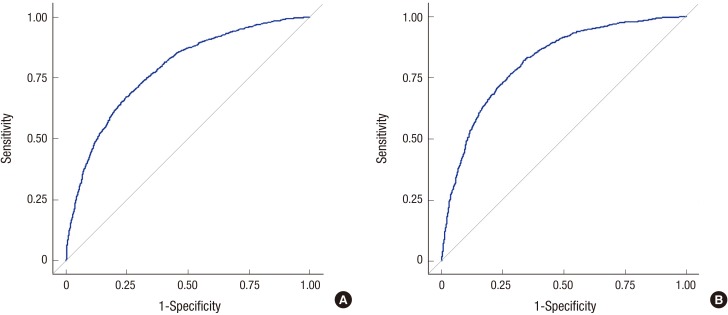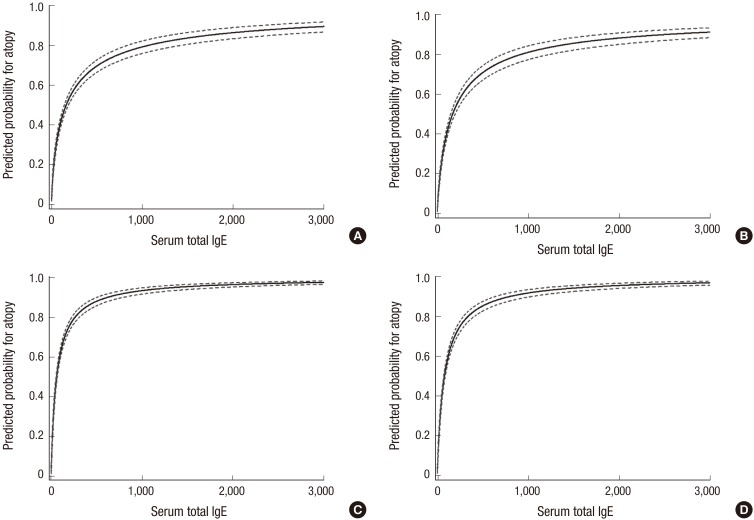J Korean Med Sci.
2017 May;32(5):803-809. 10.3346/jkms.2017.32.5.803.
Reference Values and Utility of Serum Total Immunoglobulin E for Predicting Atopy and Allergic Diseases in Korean Schoolchildren
- Affiliations
-
- 1Department of Pediatrics, Medical Research Institute of Pusan National University Hospital, Pusan National University School of Medicine, Busan, Korea.
- 2Department of Pediatrics, Samyook Medical Center, Seoul, Korea.
- 3Department of Pediatrics, Samsung Medical Center, Sungkyunkwan University School of Medicine, Seoul, Korea. jhlovechild@gmail.com
- 4Environmental Health Center for Atopic Diseases, Samsung Medical Center, Seoul, Korea.
- 5Department of Health Administration and Management, Soonchunhyang University College of Medical Science, Asan, Korea.
- 6Department of Pediatrics, Hallym University Sacred Heart Hospital, Hallym University College of Medicine, Anyang, Korea.
- 7Department of Pediatrics, Inje University College of Medicine, Seoul, Korea.
- 8Department of Occupational and Environmental Medicine, College of Medicine, Dankook University, Cheonan, Korea.
- 9Department of Pediatrics, Konkuk University Medical Center, Konkuk University School of Medicine, Seoul, Korea.
- 10Department of Pediatrics, CHA University School of Medicine, Seongnam, Korea.
- 11Department of Information and Statistics, Korea National Open University, Seoul, Korea.
- 12Department of Preventive Medicine, Dankook University College of Medicine, Cheonan, Korea.
- 13Biostatistics and Clinical Epidemiology Center, Research Institute for Future Medicine, Samsung Medical Center, Seoul, Korea.
- KMID: 2375081
- DOI: http://doi.org/10.3346/jkms.2017.32.5.803
Abstract
- The present study aimed to investigate the distribution of total serum immunoglobulin E (IgE) levels in Korean schoolchildren and to evaluate its utility in the prediction of atopy and allergic diseases. A nationwide, cross-sectional survey was conducted in first grade students from randomly selected elementary and middle schools. Total IgE levels were measured by ImmunoCAP. Skin prick tests were performed for 18 common inhalant allergens to determine the presence of atopy. Children aged 12-13 years and parents of children aged 6-7 years were asked to complete questionnaire assessing allergic diseases. The cut-off levels of total IgE were determined by analyzing receiver operating characteristic curves. The median total IgE level was 86.7 kU/L (range: 1.5-4,523.1) in 3,753 children aged 6-7 years and 94.7 kU/L (range: 1.5-3,000.0) in 3,930 children aged 12-13 years. Total IgE concentrations were higher in children with atopy or allergic diseases than in those without (all P < 0.001). At the cut-off value of 127.7 kU/L, sensitivity, specificity, and positive and negative predictive values (PPV and NPV) were 67.1%, 75.4%, 65.4%, and 76.7%, respectively, in elementary schoolchildren. At the cut-off value of 63.0 kU/L, sensitivity, specificity, PPV, and NPV were 81.9%, 66.6%, 75.0%, and 75.1%, respectively, in middle schoolchildren. PPV and NPV were ≥ 70% when cut-offs of 258.8 kU/L and 38.4 kU/L were used for the diagnosis of atopy in 6-7 year-olds and 12-13 year-olds, respectively. This nationwide population-based study provided the first normal reference ranges of total IgE in Korean schoolchildren.
Keyword
MeSH Terms
Figure
Reference
-
1. Ahn K, Kim J, Kwon HJ, Chae Y, Hahm MI, Lee KJ, Park YM, Lee SY, Han M, Kim WK. The prevalence of symptoms of asthma, allergic rhinoconjunctivitis, and eczema in Korean children: nationwide cross-sectional survey using complex sampling design. J Korean Med Assoc. 2011; 54:769–778.2. Lu KD, Phipatanakul W, Perzanowski MS, Balcer-Whaley S, Matsui EC. Atopy, but not obesity is associated with asthma severity among children with persistent asthma. J Asthma. 2016; 53:1033–1044. PMID: 27144330.3. Illi S, von Mutius E, Lau S, Niggemann B, Grüber C, Wahn U; Multicentre Allergy Study (MAS) group. Perennial allergen sensitisation early in life and chronic asthma in children: a birth cohort study. Lancet. 2006; 368:763–770. PMID: 16935687.4. Codispoti CD, Levin L, LeMasters GK, Ryan P, Reponen T, Villareal M, Burkle J, Stanforth S, Lockey JE, Khurana Hershey GK, et al. Breast-feeding, aeroallergen sensitization, and environmental exposures during infancy are determinants of childhood allergic rhinitis. J Allergy Clin Immunol. 2010; 125:1054–1060.e1. PMID: 20392478.5. Lowe PJ, Renard D. Omalizumab decreases IgE production in patients with allergic (IgE-mediated) asthma; PKPD analysis of a biomarker, total IgE. Br J Clin Pharmacol. 2011; 72:306–320. PMID: 21392073.6. Kim J, Hahm MI, Lee SY, Kim WK, Chae Y, Park YM, Han MY, Lee KJ, Kwon HJ, Jung JA, et al. Sensitization to aeroallergens in Korean children: a population-based study in 2010. J Korean Med Sci. 2011; 26:1165–1172. PMID: 21935271.7. Subbarao P, Mandhane PJ, Sears MR. Asthma: epidemiology, etiology and risk factors. CMAJ. 2009; 181:E181–E190. PMID: 19752106.8. Ahn K. The role of air pollutants in atopic dermatitis. J Allergy Clin Immunol. 2014; 134:993–999. PMID: 25439225.9. Pugliarello S, Cozzi A, Gisondi P, Girolomoni G. Phenotypes of atopic dermatitis. J Dtsch Dermatol Ges. 2011; 9:12–20. PMID: 21054785.10. Dannemiller KC, Gent JF, Leaderer BP, Peccia J. Indoor microbial communities: influence on asthma severity in atopic and nonatopic children. J Allergy Clin Immunol. 2016; 138:76–83.e1. PMID: 26851966.11. Gergen PJ, Arbes SJ Jr, Calatroni A, Mitchell HE, Zeldin DC. Total IgE levels and asthma prevalence in the US population: results from the National Health and Nutrition Examination Survey 2005-2006. J Allergy Clin Immunol. 2009; 124:447–453. PMID: 19647861.12. Simoni M, Biavati P, Baldacci S, Carrozzi L, Pedreschi M, Di Pede F, Sapigni T, Viegi G. The Po River Delta epidemiological survey: reference values of total serum IgE levels in a normal population sample of North Italy (8-78 yrs). Eur J Epidemiol. 2001; 17:231–239. PMID: 11680541.13. Uekert SJ, Akan G, Evans MD, Li Z, Roberg K, Tisler C, Dasilva D, Anderson E, Gangnon R, Allen DB. Sex-related differences in immune development and the expression of atopy in early childhood. J Allergy Clin Immunol. 2006; 118:1375–1381. PMID: 17157669.14. Kim J, Han Y, Seo SC, Lee JY, Choi J, Kim KH, Woo SY, Kim EH, Kwon HJ, Cheong HK, et al. Association of carbon monoxide levels with allergic diseases in children. Allergy Asthma Proc. 2016; 37:e1–7. PMID: 26831837.15. Kim EJ, Kwon JW, Lim YM, Yoon D, Seo JH, Chang WS, Kim HY, Park JW, Cho SH, Hong SJ, et al. Assessment of total/specific IgE levels against 7 inhalant allergens in children aged 3 to 6 years in Seoul, Korea. Allergy Asthma Immunol Res. 2013; 5:162–169. PMID: 23638315.16. De Amici M, Ciprandi G. The age impact on serum total and allergen-specific IgE. Allergy Asthma Immunol Res. 2013; 5:170–174. PMID: 23638316.17. Tu YL, Chang SW, Tsai HJ, Chen LC, Lee WI, Hua MC, Cheng JH, Ou LS, Yeh KW, Huang JL, et al. Total serum IgE in a population-based study of Asian children in Taiwan: reference value and significance in the diagnosis of allergy. PLoS One. 2013; 8:e80996. PMID: 24278361.18. Barbee RA, Halonen M, Lebowitz M, Burrows B. Distribution of IgE in a community population sample: correlations with age, sex, and allergen skin test reactivity. J Allergy Clin Immunol. 1981; 68:106–111. PMID: 7251998.19. Carosso A, Bugiani M, Migliore E, Antò JM, DeMarco R. Reference values of total serum IgE and their significance in the diagnosis of allergy in young European adults. Int Arch Allergy Immunol. 2007; 142:230–238. PMID: 17108704.20. Flohrs K, Brüske I, Thiering E, Rzehak P, Wichmann HE, Heinrich J. Temporal changes in total serum immunoglobulin E levels in East German children and the effect of potential predictors. Int Arch Allergy Immunol. 2012; 158:27–34. PMID: 22205264.21. Lindberg RE, Arroyave C. Levels of IgE in serum from normal children and allergic children as measured by an enzyme immunoassay. J Allergy Clin Immunol. 1986; 78:614–618. PMID: 3534049.22. Kulig M, Tacke U, Forster J, Edenharter G, Bergmann R, Lau S, Wahn V, Zepp F, Wahn U. Serum IgE levels during the first 6 years of life. J Pediatr. 1999; 134:453–458. PMID: 10190920.23. Hahm MI, Kim J, Kwon HJ, Chae Y, Ahn K, Lee HY. Exposure to mould allergens and rhinoconjunctivitis in Korean children. Pediatr Allergy Immunol. 2016; 27:290–298. PMID: 26663367.24. Chae Y, Hahm MI, Ahn K, Kim J, Kim WK, Lee SY, Park YM, Han MY, Lee KJ, Kwon HJ. Indoor environmental factors associated with wheezing illness and asthma in South Korean children: phase III of the International Study of Asthma and Allergies in Childhood. J Asthma. 2014; 51:943–949. PMID: 24986252.25. Bouman A, Heineman MJ, Faas MM. Sex hormones and the immune response in humans. Hum Reprod Update. 2005; 11:411–423. PMID: 15817524.26. Muñoz-Cruz S, Togno-Pierce C, Morales-Montor J. Non-reproductive effects of sex steroids: their immunoregulatory role. Curr Top Med Chem. 2011; 11:1714–1727. PMID: 21463251.27. Stone KD, Prussin C, Metcalfe DD. IgE, mast cells, basophils, and eosinophils. J Allergy Clin Immunol. 2010; 125:S73–S80. PMID: 20176269.28. Campos A, Reyes J, Blanquer A, Liñares T, Torres M. Total serum IgE: adult reference values in Valencia (1981-2004). Usefulness in the diagnosis of allergic asthma and rhinitis. Allergol Immunopathol (Madr). 2005; 33:303–306. PMID: 16371216.29. Carsin AE, Zock JP, Jarvis D, Basagaña X, Heinrich J, Toren K, Janson C, Anto JM, Sunyer J. Serum total immunoglobulin E is a surrogate of atopy in adult-onset asthma: a longitudinal study. Int Arch Allergy Immunol. 2013; 160:387–392. PMID: 23183370.30. Satwani H, Rehman A, Ashraf S, Hassan A. Is serum total IgE levels a good predictor of allergies in children? J Pak Med Assoc. 2009; 59:698–702. PMID: 19813686.31. Potaczek DP, Nasta Ek M, Wojas-Pelc A, Undas A. The relationship between total serum IgE levels and atopic sensitization in subjects with or without atopic dermatitis. Allergol Int. 2014; 63:485–486. PMID: 24851947.32. Al-Mughales JA. Diagnostic utility of total IgE in foods, inhalant, and multiple allergies in Saudi Arabia. J Immunol Res. 2016; 2016:1058632. PMID: 27314052.33. Burrows B, Martinez FD, Halonen M, Barbee RA, Cline MG. Association of asthma with serum IgE levels and skin-test reactivity to allergens. N Engl J Med. 1989; 320:271–277. PMID: 2911321.34. Sunyer J, Antó JM, Castellsagué J, Soriano JB, Roca J; The Spanish Group of the European Study of Asthma. Total serum IgE is associated with asthma independently of specific IgE levels. Eur Respir J. 1996; 9:1880–1884. PMID: 8880106.35. Carlsson M, Thorell L, Sjölander A, Larsson-Faria S. Variability of total and free IgE levels and IgE receptor expression in allergic subjects in and out of pollen season. Scand J Immunol. 2015; 81:240–248. PMID: 25620574.
- Full Text Links
- Actions
-
Cited
- CITED
-
- Close
- Share
- Similar articles
-
- Relationships between serum immunoglobulin A levels and allergic diseases in Korean children
- Relationship Between Atopy and Bronchial Hyperresponsiveness
- Changes of serum igG4 in allergic patients
- Relationship between serum total IgE, specific IgE, and peripheral blood eosinophil count according to specific allergic diseases
- Impact of helminth infection on childhood allergic diseases in an area in transition from high to low infection burden



